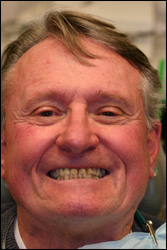





|
Crowns
A crown ("cap") is a covering that looks like a tooth, placed over a carefully prepared preexisting tooth. Crowns serve many functions, such as to strengthen, restore or improve the appearance of your natural tooth. For example, a crown can support the tooth when there is no longer sufficient tooth structure left to place a filling. Crowns may also be used to protect the structure of a tooth that is fractured or broken, and can be attached to bridges or dentures.
Step 1: The tooth is prepared to accept the replacement tooth, made of porcelain (and sometimes a thin layer of metal for support). The tooth is prepared with a slight taper to help secure the crown.
Step 2: The new crown is put in place. The carefully prepared replacement will fit under the gum tissue to hide the junction between tooth and crown.
Step 3: The crown is cemented into place using special dental adhesives. The end result will be a crown that looks and feels as natural as an ordinary tooth.
Common Materials for Crowns, Bridges, Inlays and Onlays
All-porcelain restorations have a color and translucency that look like natural tooth enamel. With several new advancements in technology, porcelain crowns have become amongst the most popular in esthetics and strength.
Porcelain fused to metal is stronger than porcelain alone. More of the existing tooth must be removed to make room for this type of restoration.
Gold alloys contain gold, copper and other metals. Less of the natural tooth may need to be removed than with some other restorations. They may cost more than other restorative options.
 |
 |
| Before | After |
|---|---|
 |
 |

Copyright © 2011 Fellows Family Dental
